| |
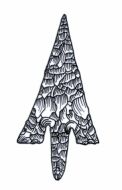 |
ADIAS Occasional Newsletter
- Feb 2005
(No.
2 - 2004-2005 Season)
Abu Dhabi Islands Archaeological Survey (ADIAS)
Patron: HH Sheikh Mohammed bin Zayed Al Nahyan
P.O. Box 45553, Abu Dhabi, U.A.E.
Tel: +9712 6934515 - Fax: +9712 6810008
Email: adias@erwda.gov.ae
Web: www.adias-uae.com
|
The ADIAS
Occasional Newsletter is edited by Dr.
Mark Beech and Peter Hellyer.
Also
available for download: Microsoft Word format (click
here - 698 Kb) or Acrobat pdf file (click
here 435 Kb).

Life in Abu Dhabi 6 million years ago - Backdrop of the
new Fossil Exhibition
DNA, Flints and Fossils
DNA from UAE's First Man
ADIAS website has record number of visitors
2nd season at Umm az-Zamul
New site at Gabat Rukhna
ADIAS Visit to Kuwait
Fossil
Display
Lectures
New Publications
Forthcoming Publication
DNA, Flints and Fossils
With the ADIAS 2004-2005
season now well under way, it's time to brief readers of the Occasional
Newsletter on some of the work undertaken over the past few months,
as well as to outline forthcoming work.
On the 20th December 2004, ADIAS held a press conference together with
the Forensic Science Laboratory at Abu
Dhabi Police Headquarters. Through DNA analysis, the Forensic Science
Laboratory has successfully identified the gender of the oldest man
so far discovered in the Emirates. In the first collaboration of its
type to have taken place in the UAE, scientists from the Forensic Science
Laboratory and archaeologists from ADIAS combined their skills to study
the oldest skeleton ever found in the United Arab Emirates. This announcement
generated a huge amount of publicity in the local, regional and international
press (for more details see below).
The second season of archaeological work at Khor Al Manahil and Kharimat
Khor Al Manahil, near Umm az-Zamul, took place from 29th December
2004 until 23rd January 2005. This work was carried out by ADIAS in
collaboration with the Department of
Antiquities and Tourism in Abu Dhabi's Eastern Region. The team
also included a visiting archaeologist from the Department of Museums
and Antiquities, Kuwait. ADIAS is pleased to acknowledge the receipt
of further sponsorship from Dolphin Energy Ltd to support this work
at Khor Al Manahil and Kharimat Khor Al Manahil (for more details see
below).
Work on the fossil display is now almost complete, after a series of
unavoidable delays. It is hoped that the inauguration of the display
will take place within a few weeks (for more details see below).
ADIAS staff have also been busy giving a series of lectures in Abu Dhabi
and Dubai (for more details see below).
Two new publications have also been issued with contributions by ADIAS
team members (for more details see below).
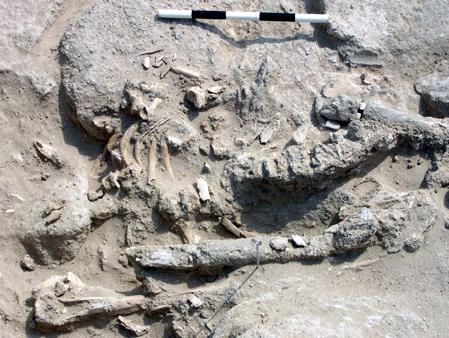
Close-up of the skeleton of the oldest human ever found in the United
Arab Emirates
DNA from UAE's First Man
In the first collaboration
of its type to have taken place in the United Arab Emirates, scientists
from the Forensic Science Laboratory at Abu
Dhabi Police Headquarters and archaeologists from ADIAS have combined
their skills to study the oldest skeleton ever found in the UAE.
The skeleton was found during excavations directed by Dr Mark Beech
for ADIAS early last year on Abu Dhabi's western island of Marawah.
During work at Site MR11, a series of stone
buildings were identified, in one of which there was a human skeleton
buried on a stone platform.
The skeleton was not well enough preserved, however, for the ADIAS team
to determine whether it was of a man or a woman.
Now, thanks to the expertise of the Police Forensic Science Laboratory,
the sex of the skeleton has been determined by the recovery of ancient
DNA. Deoxyribonucleic acid, DNA, is the chemical at the centre of the
cells of living things, which control the structure and purpose of each
cell and carries the genetic information during reproduction.
Radiocarbon dating, as well as associated finds, demonstrates that the
skeleton dates to around 7500 years ago. This makes the skeleton, and
the building in which it was found, the earliest evidence yet found
of the presence of Man in the Emirates.
Among parts of the skeleton that were preserved were several teeth,
and three of these were examined by Col. Ahmad Hassan Al-Awadi, Director
of the Forensic Science Laboratory and his team at the Forensic Pathology
Unit. Although the ancient DNA was not well preserved, using the latest
forensic science techniques, the Forensic Laboratory was able to determine
that the skeleton was a male from its DNA profile.
Preliminary studies suggest that the male individual was between approximately
20-40 years in age. Further research on the skeleton is being continued
by the Abu Dhabi Police forensic scientists, while ADIAS plans a further
season of archaeological investigations at the site next month.
ADIAS is delighted with the results of this collaboration with the Abu
Dhabi Police Forensic Laboratory. We are particularly grateful to HH
Major General Sheikh Saif bin Zayed AI Nahyan, the Minister of Interior,
for his support for our work, and look forward to further collaboration
with the police on our studies of skeletons from Abu Dhabi's coast and
islands.
The ADIAS work on Marawah is carried out in association with the Environmental
Research and Wildlife Development Agency, ERWDA, which is responsible
for the conservation of Marawah and adjacent
islands, as well as the surrounding seas, as part of the Marawah
Marine Protected Area.
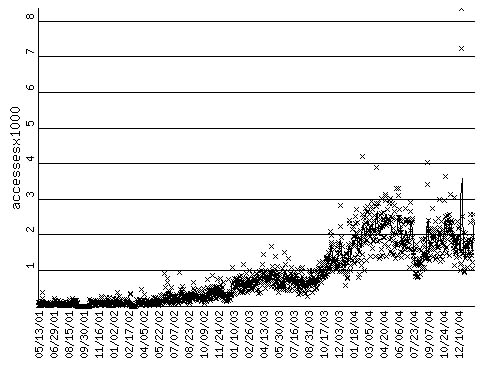
ADIAS website has record number of visitors
As a direct result of the
press conference held to announce the collaboration between ADIAS and
the Abu Dhabi Police Forensic Laboratory the ADIAS website had an unprecedented
number of visitors on 20th December 2004. A total of 8376 hits were
registered on that day, of which 718 represented unique visitors to
the website.
This is a new record for the site, whose webmaster is our Senior Resident
Archaeologist, Dr. Mark Beech.
Local press coverage of the
Marawah man DNA story fuelled international coverage of the story which
appeared in newspapers and news websites worldwide. The story was reported
in at least the following twelve countries (and we may have missed several
more):
Australia (ABC
Online, Advertiser,
The
Australian, Brisbane
Courier Mail, Daily
Telegraph, Melbourne
Herald Sun, The
Mercury, NEWS.com.au
& South
Australia Advertiser),
Bangladesh (The Daily Star),
China (People's
Daily Online),
Cuba (Granma
Internacional Digital),
India (Hindustan
Times,
India Daily
& Star
of Mysore), New
Zealand (New
Zealand Herald
& Xtra
News), Oman (The
Times of Oman),
Qatar (Gulf
Times), Slovenia
(Svarog.org), United Kingdom (Asharq
Al-Awsat, Reuters,
UK, The
Scotsman, StonePages.com,
Tiscali
News & Yahoo
News), the USA
(CNN
and CNN
International,
Free
Internet Press
& Reuters,
NY), and, of course,
the United Arab Emirates (including Al
Bayan, Gulf
News, Gulf
Today, Al
Ittihad,
Al Khaleej,
Khaleej
Times, UAEinteract.com
& Al
Watan).
The ADIAS website (www.adias-uae.com)
is now one of the most popular websites in the Middle East dealing with
the archaeology of the region.
Many thanks to Mark for his hard work on this - finding and excavating
archaeological and fossil sites is a key part of our work, but so too
is the dissemination of the results, and in today's world, the Internet
is one of the most important ways of doing that.
Comments on contents and presentation of the website are always gratefully
received.
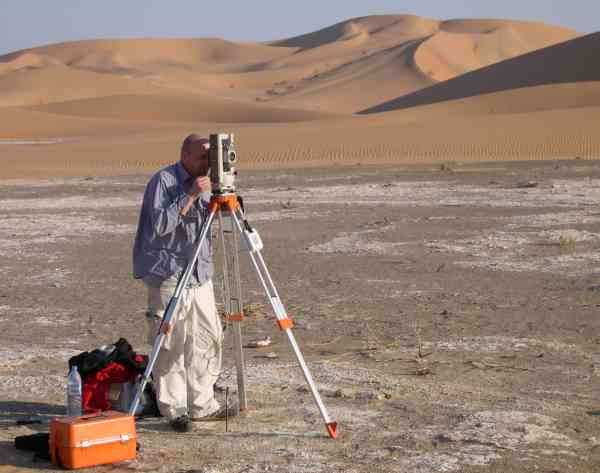
Richard Cuttler surveying at Khor Al Manahil
2nd season at Umm az-Zamul
A first field season at the
Umm az-Zamul Neolithic sites, first discovered by staff of the Environmental
Research and Wildlife Development Agency, ERWDA, in 2003, took place
in January 2004. It was carried out jointly by ADIAS and the Department
of Antiquities and Tourism in Abu Dhabi's Eastern Region. The aims
of the first season were to evaluate the potential of the archaeological
sites. Extensive lithic scatters and a remarkable collection of Neolithic
stone tools were recovered, as well as more importantly, for the first
time in the interior of the UAE desert, the presence of building structures
that are probably contemporary with the Neolithic finds. Such sites
are unique in the whole of Eastern Arabia and provide a valuable opportunity
to examine life in the desert during the Neolithic period between about
9000 - 6000 years ago.
The second season of work at Khor Al Manahil and Kharimat
Khor Al Manahil took place from the 29th December 2004 until the
23rd January 2005. This work was carried out, once again, by ADIAS in
collaboration with Department of Antiquities and Tourism. The team comprised
Dr Mark Beech (ADIAS Senior Resident Archaeologist), Richard Cuttler
(Birmingham Archaeology,
University of Birmingham, UK),
Dr Heiko Kallweit (Freiburg, Germany), Hamed Al-Mutairi (Department
of Museums and Antiquities, Kuwait) and Dr Walid Yasin Al-Tikriti (Department
of Antiquities and Tourism, Al Ain). Some field assistance was also
provided by Dr Drew Gardner (Zayed University, Abu Dhabi), Marc Dyer
and Karen Cooper (Abu Dhabi).
ADIAS is pleased to acknowledge the receipt of further sponsorship from
Dolphin Energy Ltd to support this work at Khor Al Manahil and Kharimat
Khor Al Manahil.
The aims of the second season were to:
(1) to map the extent of the archaeological sites at Khor Al Manahil,
sites KAM0001 - KAM0021.
(2) to systematically pick-up and map all lithic material from the Khor
Al Manahil sites.
(3) to make a topographic map of the terrain at Khor Al Manahil so that
the archaeological sites could be seen precisely within their landscape
context.
(4) to make a topographic map of the terrain at site KHM0035, the rich
lithics scatter first investigated during the 2004 season, so that the
archaeological site could be seen precisely within its landscape context.
(5) to map the extent of the three stone structures, sites KHM0045 -
KHM0047, at Kharimat Khor Al Manahil.
(6) to make a topographic map of the terrain surrounding sites KHM0045
- KHM0047 so that the archaeological sites could be seen precisely within
their landscape context.
Detailed mapping was carried out with the aid of a Nikon C100 Total
Station with a data logger using Fast Map FM700 logging software. Local
grid coordinates were used from stations which were fixed to national
coordinates using a hand-held GPS. The survey comprised a 3D record
of the location of each find collected plus a survey of the local topography
in order to place the flint within its current topographic location.
This represents some of the most detailed recording ever carried out
on Neolithic flint scatters in the Arabian peninsula.
The aims of the second season were all achieved, and twice as much lithic
material was collected as during the initial field season. The lithics
assemblages from Khor Al Manahil and Kharimat Khor Al Manahil now amount
to over 4000 pieces.
Future work will include the databasing, illustration and photographing
of this lithic material, so that it can be prepared for full publication.
The plan for the 2006 season includes the collection and mapping of
remaining lithic scatters as well as the involvement of palaeo-environmental
experts. Further investigation of the geology and geomorphology of the
region will help to improve our understanding of these sites within
their landscape. More importantly, it is planned to undertake optical
dating of the dunes overlying some of the Neolithic flint scatters to
give an idea of their absolute dating.
New site at Gabat Rukhna
At the invitation of HH Sheikh
Mansour bin Zayed Al Nahyan, Minister of Presidential Affairs, an ADIAS
team comprised of Peter Hellyer (Executive Director) and Simon Aspinall
(Director, Environmental Studies), visited the Gabat Rukhna plantation,
near Bida bint Saud, north of Al Ain, in early January, to examine an
area where pottery scatters had been reported.
The site proved to be a Late Islamic camping ground, with typical scatters
of locally-made and imported pottery, shells, fish-bones and - evidence
of more recent occupation - .303 rifle bullets! Several coins had already
been collected on the site by members of Sheikh Mansour's staff. While
some of these were imported, probably from Iran, and require further
study, one, minted during the reign of the mid-19th Century Omani Imam
Faisal bin Turki, provided a date for the site.
A provisional assessment of the pottery suggests that the site may have
first been used in the late 17th or early 18th Century, then continuing
in use until the early to mid 20th Centuries.
Such sites are relatively common in the deserts of Abu Dhabi, many being
located in areas where there might have been good grazing after winter
rainfall. In such cases, many seem to have been used over a period of
at least several centuries.
A more detailed assessment of the random sample of finds collected from
the site is planned. ADIAS is grateful to HH Sheikh Mansour bin Zayed
for drawing the existence of the Gabat Rukhna site to our attention.
The study of such sites can provide useful information on the lifestyle
of the people of Abu Dhabi's deserts during the Late Islamic period.
ADIAS Visit to Kuwait
Dr Mark Beech (ADIAS Senior
Resident Archaeologist) and Dr Heiko Kallweit (ADIAS associate) visited
Kuwait from the 31st January to the 3rd February 2005.
The visit was at the invitation of Shihab Shihab, director of the Department
of Museums and Antiquities, part of the National Council for Culture,
Arts & Letters in Kuwait.
On 1st February 2005 they both presented lectures to an invited audience
at the National Council for Culture, Arts & Letters. The lectures
were as follows: "Recent archaeological work on Marawah Island,
Abu Dhabi Emirate, United Arab Emirates" by Dr Mark Beech and "Archaeology
in Arabia's Deserts: Recent fieldwork at Khor Al Manahil, Abu Dhabi
Emirate, United Arab Emirates" by Dr Heiko Kallweit.
Following the lectures, they visited a number of newly-discovered archaeological
sites in Kuwait, and held meetings to discuss future collaboration and
matters of mutual interest.
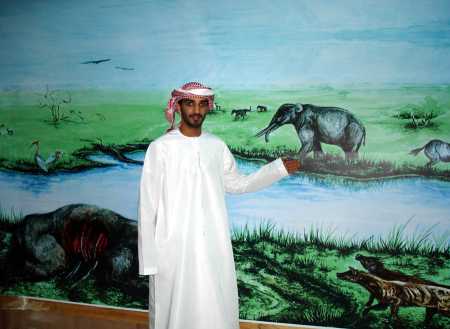
An Emirati visitor inspects the backdrop of the new fossil display
Fossil Display
Work is almost completed
on the fossil display case housed in the ERWDA headquarters. The exhibition
case is sponsored by ADCO,
Takreer and BP,
with support from ERWDA and the Private Department of HH the President.
This display will allow members of the public to see for the first time
the important Late Miocene fossils discovered in the Western Region
of Abu Dhabi emirate. Fossils of the primitive elephant species, Stegotetrabelodon
syrticus, on display include the skull, jaws and femur discovered
by the late Peter Whybrow at Shuweihat,
as well as the 2.54 metre long tusk discovered by ADIAS at Ruwais
in November 2002.
The backdrop of the display features a painted reconstruction of how
Abu Dhabi looked 6 million years ago. At that time this region was characterised
by a savannah grassland environment with plentiful acacia trees and
large rivers sweeping through the landscape. The fossils in the display
help to form a picture of this landscape and provide important information
about the range of animals that once lived in Abu Dhabi.
The display includes an audio-visual component, with two films in Arabic
and English about the fossil work. These are "Abu Dhabi - The Missing
Link" (30 minutes) and "Hot Fossils from Abu Dhabi" (5
minutes).
It is planned that the inauguration of the display will take place in
late February.
Lectures
Over the last few months,
ADIAS team members have been active in giving lectures in Abu Dhabi.
On 19th December 2004, Dr Mark Beech, ADIAS Senior Resident Archaeologist,
gave a lecture to the Scuba Diving Community in Abu Dhabi. The lecture,
co-organised by Kathleen Russell and Hazim Chalabi, was held in the
ADMA-OPCO 1st floor auditorium from 8 - 9.30 p.m. Dr Beech presented
a lecture entitled "Thoughts
on Underwater Archaeology". [ For more information click
here. ]
On the 6th February 2005, Dr Mark Beech gave a talk about the recent
archaeological work carried out on Marawah island
to the Dubai branch of the Emirates Natural History Group.
On the 8th February 2005 Dr Mark Beech also lectured to the Science
and Literary Forum (SLF) in the Delma Corner within the Cultural
Foundation in Abu Dhabi, once again on recent discoveries on Marawah.
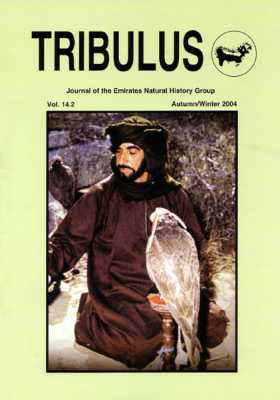
The new issue of Tribulus, vol. 14.2
New Publications
The following publications
have been issued locally since the last ADIAS Occasional Newsletter.
The latest issue of Tribulus,
the Journal of the Emirates Natural History Group, Vol. 14.2 includes
the following articles by ADIAS staff:
Beech, M. and
N. Al Shaiba. 2004. Intertidal Archaeology on Marawah Island: New Evidence
for Ancient Boat Mooring Sites. Tribulus (Journal of the Emirates Natural
History Group) 14.2: 8-16.
[ to download this article in Acrobat .pdf format click here (362 Kb) ] .
Hellyer, P.
and S. Aspinall. 2004. Zayed: Caring Environmentalist. Tribulus (Journal
of the Emirates Natural History Group) 14.2: 3-7.
[ to download this article in Acrobat .pdf format click
here (267 Kb) ] .
King, G.R.D. (with ground-plans
and elevational drawings by David Connolly). 2004. The Traditional Mosques
of Dalma, Abu Dhabi Emirate. Tribulus (Journal of the Emirates Natural
History Group) 14.2: 23-31.
[ to download this article in Acrobat .pdf format click
here (536 Kb) ] .
The Emirates Natural History Group, with the sponsorship of the Abu
Dhabi Company for Onshore Oil Operations (ADCO) has just published a
new book about the geology, archaeology and natural history of Jebel
Hafit. This is the first detailed study not only of Jebel Hafit, but
of ANY clearly-defined geographical area in the Emirates.
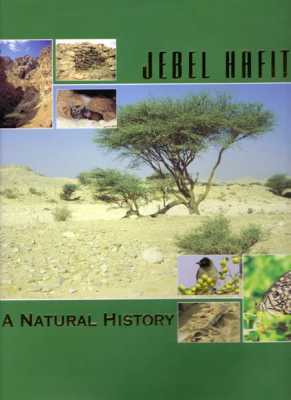
Aspinall, S. and Hellyer,
P. (eds.), 2004. Jebel Hafit: A Natural History. Emirates Natural History
Group (ENHG). Sponsored by ADCO. ISBN 9948-03-143-1.
The book features chapters
by several ADIAS staff and associates: "Geology" by Tony Kirkham
(pages 15-35), "Archaeology" by Dr. Rob Carter and Dr. Walid
Yasin Al-Tikriti (pages 48-64), "Troglobites" by Dr. Mark
Beech, Olivia Pozzan and Simon Aspinall (pages 147-8), and "Birds"
by Simon Aspinall (pages 187-220).
Copies are available from
the ADIAS office at Dh 100 each.
Forthcoming Publication
On 21st February, the Department
of Environmental Research (DER), of the Emirates Heritage Club, formerly
known as the Commission for Environmental Research (CER), will release
a new publication, the Abu Dhabi Marine Atlas. Chapters by ADIAS staff
include: "Archaeology of Abu Dhabi's Coastal Zone" by Peter
Hellyer, "Birds" by Simon Aspinall, and "Fishes"
by Dr. Mark Beech.
More news soon!
home
|







